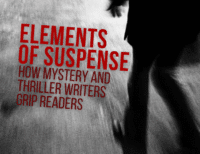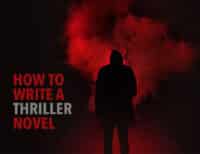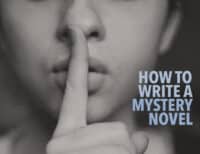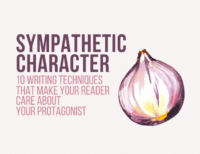You craft your story, scene by scene and sentence by sentence, stringing one word to the next with loving care. But what if, when your reader picks it up, the whole thing falls apart?

You don’t want that happening. Continuity is the thread that stitches your story into a coherent package, holding it together and making it a pleasure to read. So how do you make your writing flow?
Writing Flow: It’s All About the Transitions
As writers, we spend a lot of time trying to get our words just right. We learn how to put together effective sentences and arrange them in paragraphs. We learn how to construct a scene with all the necessary elements to hold a reader’s attention.
We learn how to create each piece of the story, but very little consideration goes toward the points of transition between those pieces. And that’s where lies the greatest risk of your reader putting down the book and walking away.
In Elizabeth George’s wonderful book Write Away, there’s a chapter titled, “Knowledge is Power, Technique is Glory.” Here’s a bit of wisdom I culled from that chapter:
“Once you have the hang of writing paragraphs that are cohesive, you’re ready to think about how to link them together so as to create a seamless narrative. This is a large part of what will propel a reader through your story, and you affect this propulsion by bridging together paragraphs, scenes, events, or actions. Bridging through the creation of transitions maintains the narrative’s smooth flow.”
She then presents a series of paragraphs from Deception on His Mind, and shows how they link together from the last sentence of one paragraph to the first sentence of the next, making the writing flow smoothly. She adds, “When you write with an awareness of bridges and transitions, you create an experience for the reader that is seductive and mysterious.”
A Look at the Micro
Let’s start by examining some ways to transition from sentence to sentence or paragraph to paragraph. In the Elizabeth George example I mentioned above, she goes on to explain that the ending sentence of one paragraph is either directly related to the first sentence of the next paragraph, or acts as a prompt.
For example, if you end a paragraph like this: “Mary wasn’t sure how she felt about Brian’s leaving.” Then it’s natural to begin the next paragraph by explaining Mary’s ambivalence: “On the one hand, she would miss him terribly. On the other hand…”
This example is rather obvious, but it makes the point. Lead the reader along a logical sequence of narrative thought, and they’ll happily go with the flow. It sounds like a no-brainer, but it’s surprising how often writers lose the thread without realizing it.
Five Techniques for Stitching Together the Small Pieces
How exactly do you transition smoothly from one sentence to the next? From one paragraph, one idea, even one word to the next?
Try these five techniques to smooth out your story and create beautiful writing flow in every line.
1. Repetition/Overlap
This technique is exactly what it sounds like: repeat the same idea at the end of one section and the beginning of the next.
Here's an example in a paragraph:
[A long paragraph, ending with . . .] In the morning, things would look brighter.
But morning brought a sullen storm that matched Kelsey’s depression.
And here's an example in dialogue:
“You’re just looking for someone to take the blame.”
“I’m looking for someone who deserves the blame.”
2. Matching sentence structure
This works well for connecting short, snappy pieces at the end of a longer piece.
Here's an example in a paragraph:
She’d win. He knew it.
She always did.
Note how I gave that last sentence an extra punch by giving it its own paragraph.
And here's an example in dialogue:
“Get out.”
“You first.”
“You wish.”
3. Turn it around
Finish a sentence or paragraph with one side of the coin, then flip it over to begin the next.
Here's an example:
[A paragraph ending with this sentence . . .] The difficulty arose because Tara didn’t understand what drew her to Steve.
With Mark, the attraction had been all too apparent.
And another example:
Peggy would find another job. She’d contact the agency, submit her resume, and—
[A new paragraph detailing the explanation might begin here.] And miss every moment of this.
4. Stimulus and response
Again, this stimulus and response, also known as cause and effect, business sounds as if it should go without saying. But it’s a trouble spot for a lot of writers and a powerful tool to have in your toolbox, so give it a little attention.
Here's an example:
Mike tossed the car keys to Sarah. [stimulus] She reached out a hand to snag them, [response] but they bounced off her forearm and hit the pavement, skittering into the gutter.
5. Sequel pattern
In his book Scene & Structure, Jack M. Bickham introduces a dandy way to create the thread of continuity we’ve been discussing. He calls it “Scene and Sequel.” It’s a lot more complex than I can get into here, but I wanted to point out the pattern he uses for his sequels: Emotion—thought—decision—action.
After an action scene, the character will have an emotional response, which will lead to thoughts about the action and response, which will leave her with a decision to be made. That decision will lead to another action, and so it begins again.
Big Picture Mechanics
We’ve looked at some techniques for achieving continuity and writing flow in the small spaces of your story. Let’s touch on some things you can do to create a sense of unity throughout your entire story.
1. Consistent details
By this, I mean using details that weave a consistent thread throughout the story, especially in terms of tone and atmosphere.
Think about the imagery and language you’re using and stay true to the overall picture you want to portray. Like an architect who designs his buildings to fit the environment and plans the landscaping to suit the building so that a harmonious whole is created.
2. Unify around theme
In my article on immersing your reader in the setting of your story, I talked about using a central element or symbol to bind the moving pieces of your story into a coherent whole.
I used the example of a river. Establish the importance of the river early on. You don’t have to state this—simply describe it in significant detail, and your reader will sense its substance.
Then refer back to the river at certain points and that river becomes the thematic ribbon running through your story.
3. Character traits or features
This is similar to #2, but centers on the attributes of your characters. For instance, you might have a character who walks with a cane and that cane comes into play, symbolically and physically, throughout the story.
4. Setup and payoff
Keeping up a running sequence of setups and payoffs creates continuity, propelling your reader forward.
Little efforts that pay off big
By learning how to achieve continuity in your writing, you magnify your efforts into something magnificent. This is the type of synergy Aristotle had in mind when he coined the phrase: “The whole is greater than the sum of its parts.”
Continuity is a powerful thing.
Are you aware of continuity and writing flow when you read a book? Tell us about it in the comments.
PRACTICE
You probably already use many of these methods without even thinking about it. But as my mentor always tells me, being aware of a technique gives your subconscious permission to use it.
So, let’s focus on awareness and write a scene of at least six paragraphs woven together with a thread of continuity. Remember to use at least two or three of the techniques discussed in the article to increase your awareness of them.
If you’d like to use a prompt, choose one of these:
Two strangers meet at a birthday party.
Chad goes to bed in the year 2020, and wakes up in 1849.
Barnaby’s hotel is going under and he has to let the staff go.
Write for fifteen minutes. When you’re finished, post your work in the comments, and be sure to provide feedback for your fellow writers!







0 Comments
Trackbacks/Pingbacks